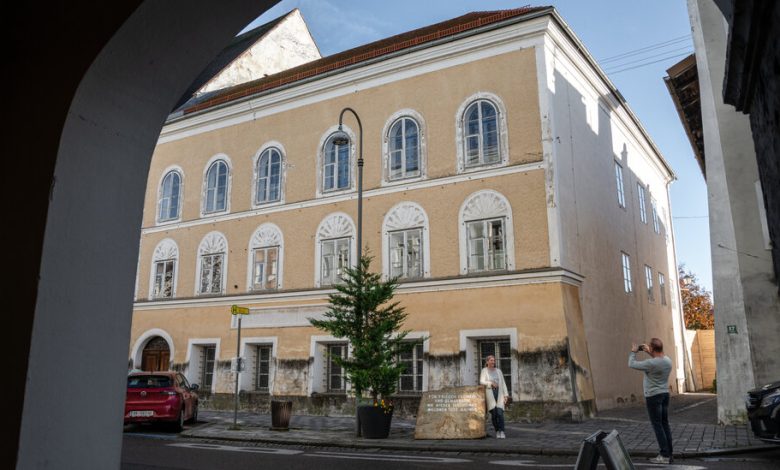In Hitler’s Birthplace, Soul-Searching Over a Poisonous Past

The Austrian town of Braunau am Inn, sitting just at the border with Germany, has a 15th-century church tower, cobblestone streets and cluttered rows of charming, colorful houses, some in green, pink and blue.
It also has a fraught historical burden. On the upper floors of the house at Salzburger Vorstadt 15 on April 20, 1889, Adolf Hitler was born.
One recent afternoon, Annette Pommer, 32, a history teacher, stared through the window of the Sailer cafe at the three-story 17th-century building across the street where Hitler spent the first few months of his life. She could hear the pounding of jackhammers; an excavator was crawling over a pile of bricks at the rear of the house while workers in hard hats swept the soil.
For many years, Braunau residents say, few gave the house a second thought, except when tourists asked for a photograph, or the occasional neo-Nazi showed up on the anniversary of Hitler’s birthday with a candle or wreath.
But in 2017, the Austrian government, acutely sensitive to the house’s poisonous symbolism and potential for abuse, expropriated the property, and after a period of debate, announced the building would be renovated to become a police station. The goal was to stop it from attracting any modern supporters of Hitler and to sever associations with its painful history. Construction began in October.
“It’s a missed opportunity,” Ms. Pommer said.
Like many in Braunau, she had wanted the building to become a museum or exhibition space to explore Austria’s part in the Nazi regime, a usage that could provide an especially valuable lesson at a time when war again rages in Europe, antisemitism is rising and far-right parties are stirring.
“It should be about how people become Hitler,” she said. “It’s not a house of evil. It’s just a house where a child was born. But it’s right to explain what became of that child.”
When Alois Hitler, a customs clerk, and Klara, his third wife, rented rooms in the house and had their son, Adolf, the building was home to a tavern. Within a year, the family moved elsewhere in town, and after two more years, left for Passau, Germany, another border town.
In 1938, the house was acquired for the Nazi party by Martin Bormann, a high-ranking Nazi official, and the street was renamed Adolf-Hitler-Strasse. The building became a public library and gallery for approved local artists — and turned into something of a place of pilgrimage.
After the war, the house was returned to the family that had previously owned it, and it was rented out as a library, then a school and later a bank. In 1972, the government assumed the lease to prevent the house from being exploited for any glorification of Nazi ideology. In 1977, the house was occupied by an organization for people with disabilities.
That group moved out in 2011, and in 2017, Parliament passed an act to seize the property, paying 812,000 euros ($882,000) in compensation.
But the empty house prompted a period of renewed soul-searching about how it should be used: A home for refugees? A place to celebrate Austrians who protected Jewish people and resisted Hitler? A center for studying peace and war?
A government-appointed Commission on the Historically Correct Treatment of Adolf Hitler’s Birthplace recommended against demolition because “Austria should not be allowed to deny the history of the site,” it said. But the commission concluded that the property couldn’t become a museum, arguing that it would then continue to be associated with Hitler. It called for a “profound architectural redesign that would deprive the building of its recognition value and thus its symbolic power.”
In the end, the government decided to put a police station in the building, including a regional police command.
The renovated structure — with two new buildings at the back, a human rights training office and a reconstructed front — will cost 20 million euros ($21.75 million) and be ready for the police to move in by 2026.
Florian Kotanko, a retired teacher and local historian, said many here would prefer that the building still housed the organization for people with disabilities because that directly contradicted what Hitler, who persecuted disabled people, would have wished.
“It’s an unwanted heritage,” Mr. Kotanko said, standing at the back of the house where a temporary wooden fence separated it from a neighboring budget supermarket. “But we have to cope with it.”
He thinks the police station decision could potentially backfire. Rather than Hitler fans being deterred, he said, they might see it as a matter of pride to be arrested and to spend time inside.
Hitler wrote about his birthplace at the opening of “Mein Kampf,” but there is scant evidence of his presence around the town.
Some residents said they were indifferent about the house. After all, there are other worries, like jobs, in a town where an aluminum plant and umbrella factory are among the biggest employers.
“Leave it empty,” said Sylvia Berghammer, 53, who works in Zagler’s bakery down the street. “It’s not good for our children to discuss.”
“It’s the past,” said Ammar Alkhatib, 15, a student wearing a backpack who was standing in a doorway opposite the house.
But more people expressed dismay about the police moving in, agreeing with Ms. Pommer that the house should be used to mark and examine history.
In 1989, the town’s mayor set a granite stone in front of the house that came from a quarry at the site of the Mauthausen concentration camp, 80 miles away. It bears an inscription: “For Peace, Freedom and Democracy. Never Again Fascism. Millions of Dead Are a Warning.”
When the fate of the house was being debated, officials in the Interior Ministry suggested moving that stone. Townspeople protested, and because it rests on municipal, not federal, land, it is staying.
Still, some say that’s not enough.
Sitting in the failing afternoon light in a nearby hotel, Eveline Doll, 56, a former journalist who grew up in the town, said that for a long time after the war, there was a feeling among Austrians that they had been victims of Nazi Germany. When she was a girl, she told visitors that the house had nothing to do with her.
But since the 1980s, she said, there has been a widening realization that Austria was not the innocent, idyllic place of its self-image. While some Austrians did resist, many followed Hitler and helped perpetrate his crimes. She wishes the house could be central to the national conversation about the historical truth and could stand for a message of tolerance.
“You should never forget the beginning — that’s the thing — and be aware of when things are getting problematic, and they are nowadays,” she said.
Günter Schwaiger, an Austrian filmmaker who has made a film about the town and the house, said in an interview that the Nazis should not be remembered only at places like concentration camps.
“To close the doors of the house and to change the facade means only to continue the politics of repression of the truth,” he said. “This house — as a symbol for a normal place in a normal little city — stands for the fact that Nazis didn’t come from outside or from ‘another planet.’ They came from our midst.”




